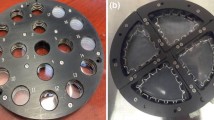Abstract
In this study, nanoparticle emission of TiO2 nanopowder coated on different substrates including wood, polymer, and tile, was evaluated in a simulation box and measured with a Scanning Mobility Particle Sizer (SMPS) for the first time. The coating process for the substrate followed the instructions given by the supply company. In the simulation box, UV light, a fan, and a rubber knife were used to simulate the sun light, wind, and human contacting conditions. Among the three selected substrates, tile coated with TiO2 nanopowder was found to have the highest particle emission (22 #/cm3 at 55 nm) due to nanopowder separation during the simulation process. The UV light was shown to increase the release of particle below 200 nm from TiO2 nanopowder coating materials. The results show that, under the conditions of UV lamps, a fan and scraping motion, particle number concentration or average emission rate decreases significantly after 60 and 90 min for TiO2/polymer and TiO2/wood, respectively. However, the emission rate continued to increase after 2 h of testing for TiO2/tile. It is suggested that nanoparticle emission evaluation is necessary for products with nanopowder coating.
Similar content being viewed by others
References
Aitken R.J., Creely K.S., Tran C.L., (2004) Nanoparticles: an occupational hygiene review. Institute of Occupational Medicine. Res. Rep. 274:12–15
Chen T.M. & H.M. Chein, 2003. Nanoparticle generation and monitoring. Center for Environmental Safety & Health Technology Development, Industrial Technology Research Institute, pp. 58–78 (in Taiwan)
Elder A.C.P., Gelein R., Azadniv M., Frampton M., Finkelstein J., Oberdorster G. (2002) Systemic interactions between inhaled ultra fine particles and endotoxin. Ann. Occup. Hyg. 46(Suppl. 1):S231–S234
Elder A.C.P., Gelein R., Azadniv M., Frampton M., Finkelstein J., Oberdorster G. (2004) Systemic effects of inhaled ultra fine particles in two compromised, aged rat strains. Inhal. Toxicol. 16(6/7):461–471
Elder A.C.P., Gelein R., Finkelstein J.N., Cox C., Oberdörster G. (2000) Pulmonary inflammatory response to inhaled ultra fine particles is modified by age, ozone exposure, and bacterial toxin. Inhal. Toxicol. 12(Suppl. 4):S227–S246
Ferin J., Oberdörster G., Soderholm S.C., Gelein R. 1991. Pulmonary tissue access of ultra fine particles. J. Aerosol Med. 4(1):57–68
Ferin J., Oberdörster G. (1992) Translocation of particles from pulmonary alveoli into the interstitium. J. Aerosol Med. 5(3):179–187
Kreyling W., Semmler M., Erbe F., Mayer P., Takenaka S., Schulz H., et al. (2002) Translocation of ultra fine insoluble iridium particles from lung epithelium to extra pulmonary organs is size dependent but very low. J. Toxicol. Environ. Health 65A (20):1513–1530
Li X., Brown D., Smith S., MacNee W., Donaldson K. (1999) Short-term inflammatory responses following intratracheal instillation of fine and ultra fine carbon black in rats. Inhal. Toxicol. 11:709–731
Nemmar A., Delaunois A., Nemery B., Dessy-Doize C., Beckers J.F., Sulon J., et al. (1999) Inflammatory effect of intratracheal instillation of ultra fine particles in the rabbit: role of C-fiber and mast cells. Toxicol. Appl. Pharmacol. 160:250–261
Nemmar A., Hoet P.H.M., Vanquickenborne B., Dinsdale D., Thomeer M., Hoylaerts M.F., et al. 2002a. Passage of inhaled particles into the blood circulation in humans. Circulation 105:411–414
Nemmar A., Hoylaerts M.F., Hoet P.H.M., Dinsdale D., Smith T., Xu H., et al. (2002b) Ultra fine particles affect experimental thrombosis in an in vivo hamster model. Am. J. Respir. Crit. Care Med. 166:998–1004
Nemmar A., Hoylaerts M.F., Hoet P.H.M., Vermylen J., Nemery B. 2003. Size effect of intratracheally instilled particles on pulmonary inflammation and vascular thrombosis. Toxicol. Appl. Pharmacol. 186:38–45
Oberdörster G., Ferin J., Gelein R., Soderholm S.C., Finkelstein J. (1992a) Role of the alveolar macrophage in lung injury: studies with ultra fine particles. Environ. Health Persp. 97:193–197
Oberdörster G., J.N. Finkelstein, C. Johnston, R. Gelein, C. Cox, R. Baggs et al., 2000. HEI Research Report: Acute Pulmonary Effects of Ultra fine Particles in Rats and Mice HEI Research Report. No. 96: Health Effects Institute
Oberdörster G., Gelein R.M., Ferin J., Weiss B. (1995) Association of particulate air pollution and acute morality: involvement of ultra fine particles? Inhal. Toxicol. 7:111–124
Oberdörster G., Sharp Z., Atudorei V., Elder A., Gelein R., Kreyling W., et al. (2004) Translocation of inhaled ultra fine particles to the brain. Inhal. Toxicol. 16(6/7):437–445
Oberdörster G., Sharp Z., Atudorei V., Elder A., Gelein R., Lunts A., et al. (2002) Extra pulmonary translocation of ultra fine carbon particles following whole-body inhalation exposure of rats. J. Toxicol. Environ. Health 65A:1531–1543
Oberdörster G., Maynard A., Donaldson K., et al. (2005) Principles for characterizing the potential human health effects from exposure to nanomaterials: elements of a screening strategy. Part. Fibre Toxicol. 2:8
Roco M.C., (2005) International perspective on government nanotechnology funding in 2005. J. Nanopart. Res. 7:707–712
Zhou Y.-M., Zhong C.-Y., Kennedy I.M., Leppert V.J., Pinkerton K.E. (2003) Oxidative stress and NFkB activation in the lungs of rats: a synergistic interaction between soot and iron particles. Toxicol. Appl. Pharmacol. 190:157–169
Author information
Authors and Affiliations
Corresponding author
Rights and permissions
About this article
Cite this article
Hsu, LY., Chein, HM. Evaluation of nanoparticle emission for TiO2 nanopowder coating materials. J Nanopart Res 9, 157–163 (2007). https://doi.org/10.1007/s11051-006-9185-3
Received:
Accepted:
Published:
Issue Date:
DOI: https://doi.org/10.1007/s11051-006-9185-3




